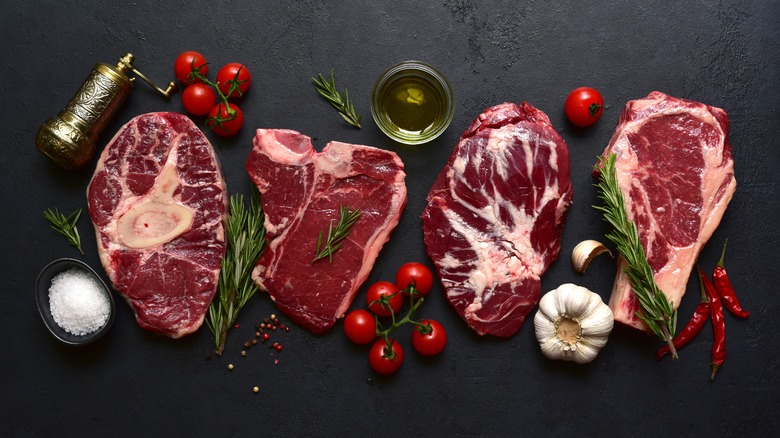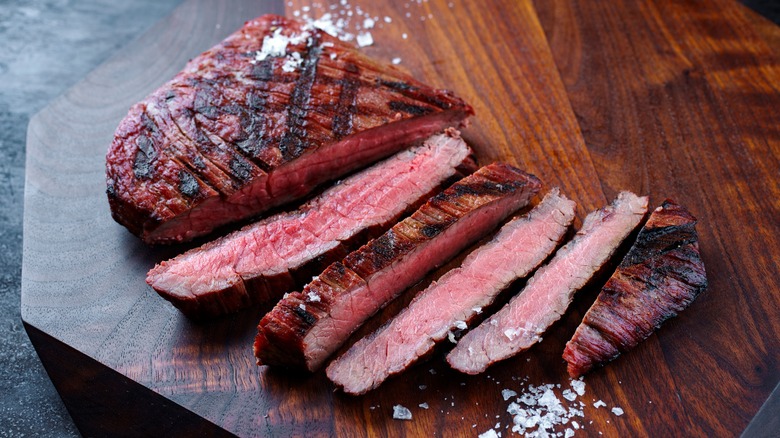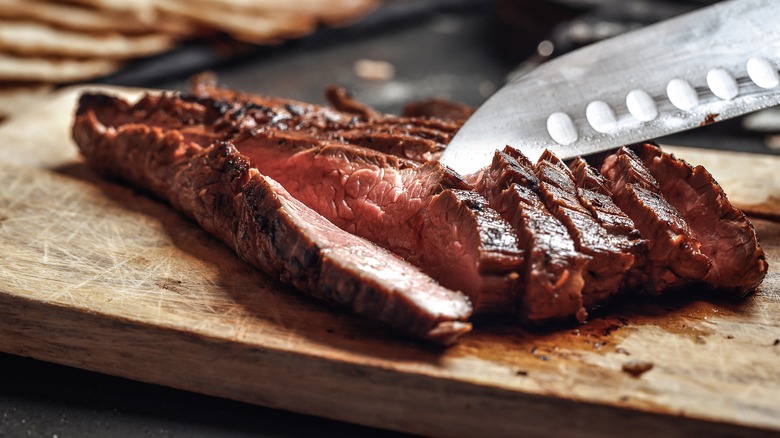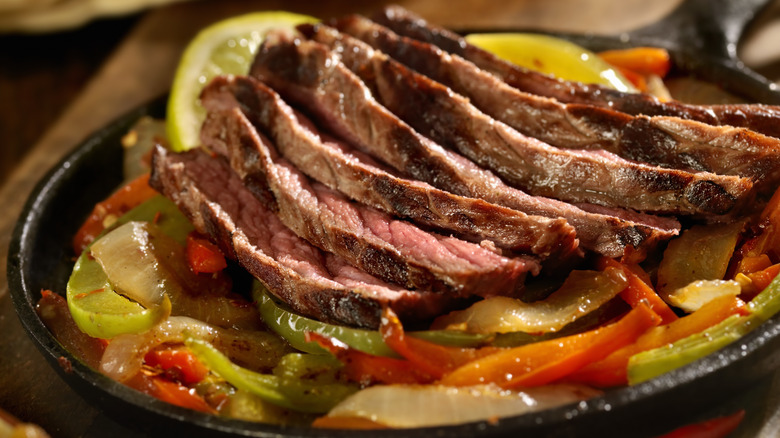Flat Iron Vs Flank Steak: What's The Difference?
Flat iron steak and flank steak may come from opposite ends of the cow, but there are quite a few similarities between these two cuts of beef. Both are versatile, affordable, and often cooked via fast, high-heat methods like grilling or pan-searing, making them great options for a variety of dishes. They both come from relatively tough areas of the cow, yet can deliver excellent flavor when prepared correctly. Both are rather lean, but these steaks are still packed with beefy goodness and are a vital ingredient for flavorful recipes like sandwiches and stir-fries.
As similar as these cuts are, they also have many unique characteristics, especially when it comes to their textures, tenderness, and fat content. In general, flat iron steak is known for its natural marbling and tender texture, while flank steak is leaner and requires more preparation to properly tenderize. Either steak is a delicious option, but understanding what sets them apart can help you choose the right cut depending on your cooking method and the texture you're aiming for.
Flat iron steak is extra tender
Flat iron steak comes from the cow's shoulder, also known as the chuck. Thanks to the generous amount of marbling that runs throughout the cut, flat iron is extremely tender, which is unusual for other shoulder cuts. This marbling, which refers to the white, fine lines of fat that run throughout the meat, renders as it cooks to create a rich and juicy texture. Flat iron steak is often described as having an earthy, gamey flavor. Since you don't have to take any extra steps to tenderize the steak, flat iron is a good choice for beginner chefs.
All you have to do to bring out the flavors of flat iron steak is to coat it with salt and pepper before you start cooking. Flat iron does well with direct heat, so cooking it on a grill or pan is your best bet. If you're new to cooking steaks, make sure to check out Chowhound's guide to pan-searing first! This is a thin cut of steak, so it won't take very long to reach your desired level of doneness. It's recommended not to overcook this cut, or it can become tough. Keep a meat thermometer on hand, and take the steak off the heat once it reaches an internal temperature of around 130 degrees Fahrenheit for medium rare.
Flank steak is lean
On the other side of the cow, around the lower stomach area, is the flank steak. This cut is known for its leanness and intense beefy flavor, and while it's naturally tougher than flat iron, it compensates with a deep, rich taste that shines in dishes where the meat can be marinated. It's a popular option for any recipe that calls for strips of beef, as this preparation keeps the steak's toughness from overshadowing the other flavors. Flank steak is also one of the tastiest cuts of steak that won't break the bank.
Before you cook flank steak, you'll have to tenderize it either manually or by letting in sit in a marinade. This cut is incredibly versatile and can be cooked in a range of ways, from grilling to broiling. Flank steak is best when cooked quickly at high heat, like on a grill. Heating the steak slowly can cause it to become overly tough and chewy. No matter how you cook your flank steak, always slice it thinly against the grain afterwards to increase the amount of tender, juicy surface area. Since flank steak and flat iron steak are so easy to cook, they're a terrific option for quick weeknight dinners.
Two affordable steaks
When it comes to price and availability, both flat iron steak and flank steak are relatively accessible cuts of beef, though that can differ slightly depending on location and season. In-the-know steak fanatics praise flat iron for being such an affordable yet high quality cut. It's widely available at most grocery stores and butcher shops, especially during grilling season. Because it's less well-known than some other cuts, it tends to be cheaper (around $9 per pound), making it a great choice for those looking for a high-quality steak on a budget.
Flank steak, on the other hand, can be slightly more expensive at about $13 per pound, but it's still worth it to enjoy or alone or to make dishes like fajitas. Flank steak is also available year-round at most supermarkets and butcher shops, but the price can fluctuate depending on availability and demand. It's a versatile cut that can be used in a range of dishes, so it's a bit more popular (and therefore slightly less affordable) than flat iron steak. Whichever cut you go for, don't forget to add some of these simple additions to take your steak to another level.



